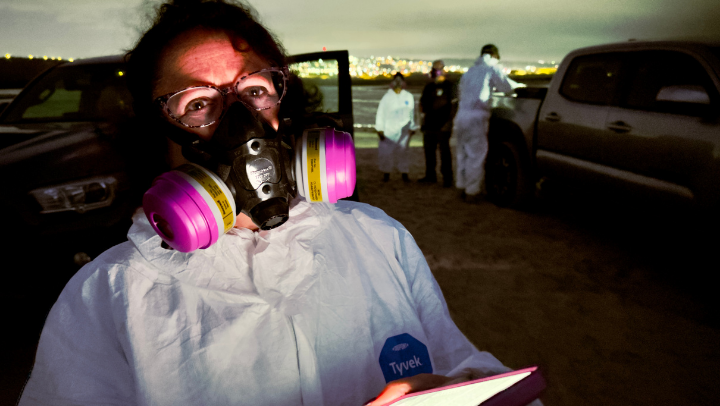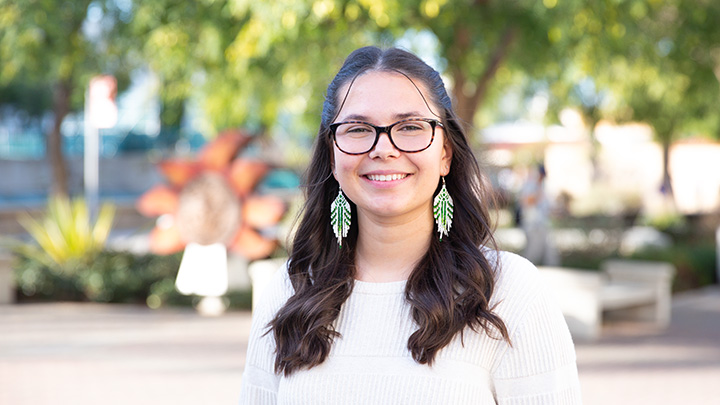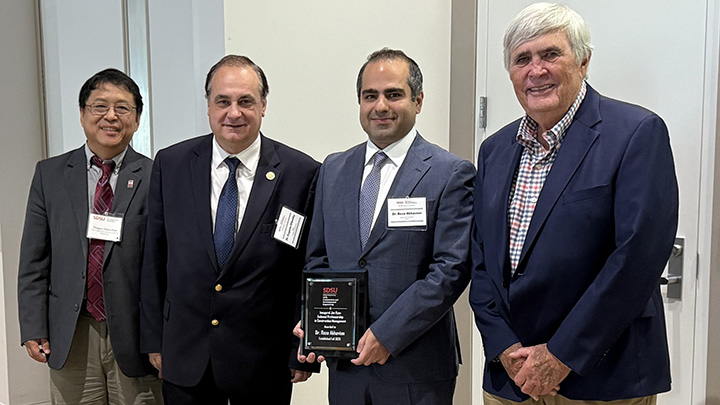SDSU at the front lines of South Bay air pollution crisis
Research into hydrogen sulfide emissions is informing public health action on both sides of the border.

San Diego State University researchers continue to detect high levels of toxic gas from the Tijuana River in densely populated South Bay neighborhoods, months after upgrades to Tijuana’s aging wastewater treatment plant.
Led by Paula Stigler Granados, associate professor and head of Environmental Health at SDSU’s School of Public Health, the scientists are working to intervene as hydrogen sulfide, the gas behind the rotten egg stench, continues to pollute the air in communities on both sides of the border.
"We found a statistically significant correlation between people who smelled bad odors frequently, at least four times a week, and increased incidence of respiratory illness, gastrointestinal illness, and sleep disturbances,” said Stigler Granados.
Elected as science advisor to the San Diego County Air Pollution Control District on March 1, Stigler Granados is now helping guide policy decisions on air quality and public health, ensuring SDSU’s research not only informs the public but also shapes how the region responds to pollution crisis like the one unfolding along the Tijuana River.
Hydrogen sulfide (H₂S), labeled a poisonous gas by the Occupational Safety and Health Administration (OSHA), forms when bacteria break down organic matter. It poses a serious health hazard, capable of causing respiratory problems, neurological damage, and, in high concentrations, death.
Even breathing in at “lower levels over time can also harm your health, affecting the lungs, brain, and overall well-being,” said Stigler Granados.
In September 2024, extreme heat and sewage surges overwhelmed the U.S. portion of the Tijuana River, releasing up to 80 million gallons of sewage each day into surrounding neighborhoods. The result was a smelly but invisible plume of H₂S gas following the river’s path.
The California Air Resources Board’s ambient air standard for hydrogen sulfide gas is just 30 parts per billion (ppb). However, Stigler Granados' team recorded significantly higher levels in the air, including spikes of 4,000 ppb near the river and surrounding neighborhoods, far exceeding long-term exposure guidelines.
To investigate the crisis, SDSU and University of California San Diego researchers teamed up with colleagues from Texas who used gas-detecting “sniffer trucks” and drones to collect air pollution data from the surrounding communities.
The scientists released their recorded data at a Sept. 10 press conference. The next day, Mexico diverted sewage and the river flow, causing the hydrogen sulfide levels to plummet.
"That’s when we could confidently say that the sewage flowing into the river was responsible for both the foul odor and the hazardous air pollution,” said Stigler Granados.
Despite the short-term improvement, affected communities still face increased health risks due to recurring gas spikes from the river.
According to the San Diego Air Pollution Control District's real-time monitoring system, hydrogen sulfide levels continue to spike frequently in the region, well above the 30 parts per billion "nuisance level" threshold, particularly at night when they sometimes reach nearly 400 parts per billion.
SDSU’s principal investigators, Stigler Granados, Penelope “Jenny” Quintana and Yu Ni, continue to advocate for cleaner air in the region and have launched the Healthy Water-Healthy Air survey to track health and environmental impacts. The survey is open to anyone living in an impacted neighborhood.
In April, Environmental Protection Agency Administrator Lee Zeldin toured the South Bay with a bipartisan congressional delegation. “We will develop one comprehensive list of everything that we believe with complete confidence is going to end the crisis,” Zeldin said.
Just one week later, on April 28, Tijuana’s wastewater treatment plant — located six miles south of the U.S.–Mexico border — became fully operational after years of delays and extensive repairs. The plant can now treat up to 18 million gallons of sewage daily.
Despite that progress, local officials warn the plant’s capacity is still too small to handle the volume of wastewater flowing from Tijuana — and that air and water pollution continue to pose public health threats. In response, the U.S. International Boundary and Water Commission and the EPA announced they will be increasing the capacity of the South Bay International Wastewater Treatment Plant from 25 to 35 million gallons per day within 100 days as opposed to two years as previously planned.
However, even with cross-border cooperation and long-overdue infrastructure upgrades, sustained investment in research and public health remains essential, said Stigler Granados.
“This isn’t a one-time fix, the community needs ongoing support to understand, track and ultimately reduce the long-term health risks,” she said.
That’s why The Prebys Foundation’s $872,000 commitment, announced last August, is so important. A portion of their funding, about $437,000, supports SDSU-led research aimed at advancing science-based solutions to the Tijuana sewage crisis and protecting the health of South Bay residents.



